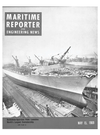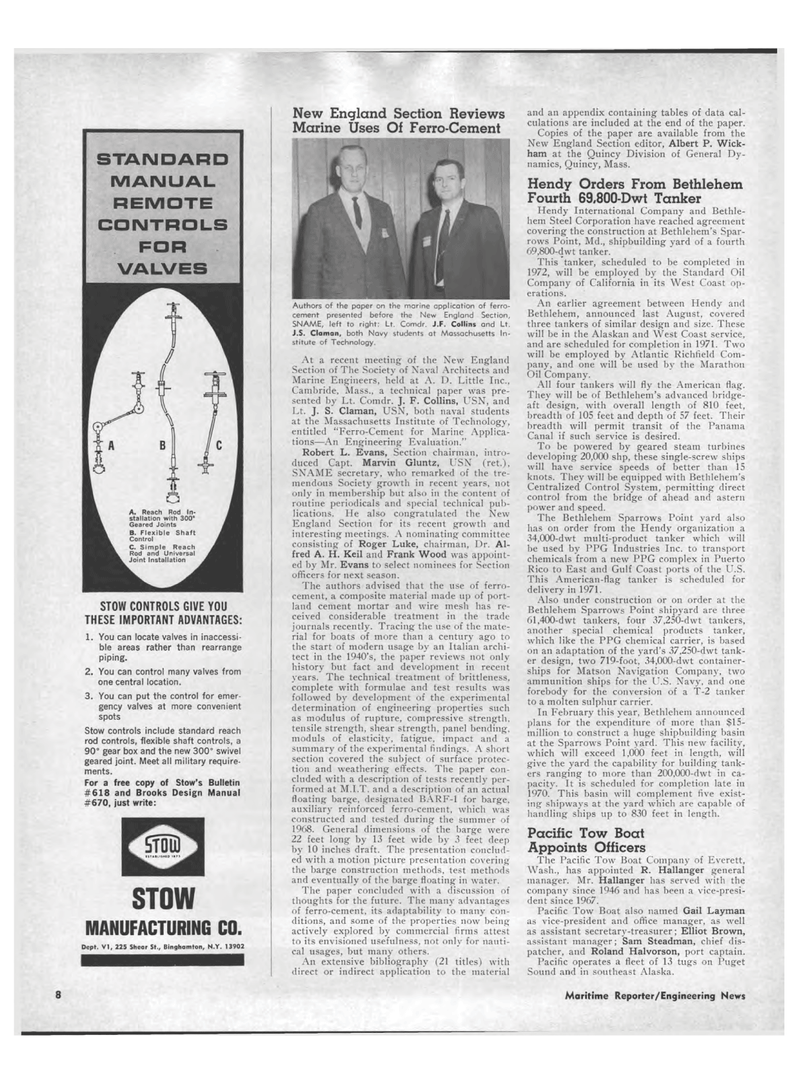
Page 6: of Maritime Reporter Magazine (May 15, 1969)
Read this page in Pdf, Flash or Html5 edition of May 15, 1969 Maritime Reporter Magazine
STANDARD MANUAL VALVES STOW CONTROLS GIVE YOU THESE IMPORTANT ADVANTAGES: 1. You can locate valves in inaccessi-ble areas rather than rearrange piping. 2. You can control many valves from one central location. 3. You can put the control for emer-gency valves at more convenient spots Stow controls include standard reach rod controls, flexible shaft controls, a 90° gear box and the new 300° swivel geared joint. Meet all military require-ments. For a free copy of Stow's Bulletin #618 and Brooks Design Manual #670, just write: STOW MANUFACTURING CU. Dept. VI, 225 Sheer St., Binghamton, N.Y. 13902 New England Section Reviews Marine Uses Of Ferro-Cement Authors of the paper on the marine application of ferro-cement presented before the New England Section, SNAME, left to right: Lt. Comdr. J.F. Collins and Lt. J.S. Cloman, both Navy students at Massachusetts In-stitute of Technology. At a recent meeting of the New England Section of The Society of Naval Architects and Marine Engineers, held at A. D. Little Inc., Cambride, Mass., a technical paper was pre-sented by Lt. Comdr. J. F. Collins, USN, and Lt. J. S. Claman, USN, both naval students at the Massachusetts Institute of Technology, entitled "Ferro-Cement for Marine Applica-tions?An Engineering Evaluation." Robert L. Evans, Section chairman, intro-duced Capt. Marvin Gluntz, USN (ret.), SNAME secretary, who remarked of the tre-mendous Society growth in recent years, not only in membership but also in the content of routine periodicals and special technical pub-lications. He also congratulated the New England Section for its recent growth and interesting meetings. A nominating committee consisting of Roger Luke, chairman, Dr. Al-fred A. H. Keil and Frank Wood was appoint-ed by Mr. Evans to select nominees for Section officers for next season. The authors advised that the use of ferro-cement, a composite material made up of port-land cement mortar and wire mesh has re-ceived considerable treatment in the trade journals recently. Tracing the use of the mate-rial for boats of more than a century ago to the start of modern usage by an Italian archi-tect in the 1940's, the paper reviews not only history but fact and development in recent years. The technical treatment of brittleness, complete with formulae and test results was followed by development of the experimental determination of engineering properties such as modulus of rupture, compressive strength, tensile strength, shear strength, panel bending, moduls of elasticity, fatigue, impact and a summary of the experimental findings. A short section covered the subject of surface protec-tion and weathering effects. The paper con-cluded with a description of tests recently per-formed at M.I.T. and a description of an actual floating barge, designated BARF-1 for barge, auxiliary reinforced ferro-cement. which was constructed and tested during the summer of 1968. General dimensions of the barge were 22 feet long by 13 feet wide by 3 feet deep by 10 inches draft. The presentation conclud-ed with a motion picture presentation covering the barge construction methods, test methods and eventually of the barge floating in water. The paper concluded with a discussion of thoughts for the future. The many advantages of ferro-cement, its adaptability to many con-ditions, and some of the properties now being actively explored by commercial firms attest to its envisioned usefulness, not only for nauti-cal usages, but many others. An extensive bibliography (21 titles) with direct or indirect application to the material and an appendix containing tables of data cal-culations are included at the end of the paper. Copies of the paper are available from the New England Section editor, Albert P. Wick-ham at the Quincy Division of General Dy-namics, Quincy, Mass. Hendy Orders From Bethlehem Fourth 69,800-Dwt Tanker Hendy International Company and Bethle-hem Steel Corporation have reached agreement covering the construction at Bethlehem's Spar-rows Point, Md., shipbuilding yard of a fourth 69,800-dwt tanker. This tanker, scheduled to be completed in 1972, will be employed by the Standard Oil Company of California in its West Coast op-erations. An earlier agreement between Hendy and Bethlehem, announced last August, covered three tankers of similar design and size. These will be in the Alaskan and West Coast service, and are scheduled for completion in 1971. Two will be employed by Atlantic Richfield Com-pany, and one will be used by the Marathon Oil Company. All four tankers will fly the American flag. They will be of Bethlehem's advanced bridge-aft design, with overall length of 810 feet, breadth of 105 feet and depth of 57 feet. Their breadth will permit transit of the Panama Canal if such service is desired. To be powered by geared steam turbines developing 20,000 shp, these single-screw ships will have service speeds of better than 15 knots. They will be equipped with Bethlehem's Centralized Control System, permitting direct control from the bridge of ahead and astern power and speed. The Bethlehem Sparrows Point yard also has on order from the Hendy organization a 34,000-dwt multi-product tanker which will be used by PPG Industries Inc. to transport chemicals from a new PPG complex in Puerto Rico to East and Gulf Coast ports of the U.S. This American-flag tanker is scheduled for delivery in 1971. Also under construction or on order at the Bethlehem Sparrows Point shipyard are three 61,400-dwt tankers, four 37,250-dwt tankers, another special chemical products tanker, which like the PPG chemical carrier, is based on an adaptation of the yard's 37,250-dwt tank-er design, two 719-foot, 34,000-dwt container-ships for Matson Navigation Company, two ammunition ships for the U.S. Navy, and one forebody for the conversion of a T-2 tanker to a molten sulphur carrier. In February this year, Bethlehem announced plans for the expenditure of more than $15-million to construct a huge shipbuilding basin at the Sparrows Point yard. This new facility, which will exceed 1,000 feet in length, will give the yard the capability for building tank-ers ranging to more than 200,000-dwt in ca-pacity. It is scheduled for completion late in 1970. This basin will complement five exist-ing shipways at the yard which are capable of handling ships up to 830 feet in length. Pacific Tow Boat Appoints Officers The Pacific Tow Boat Company of Everett, Wash., has appointed R. Hallanger general manager. Mr. Hallanger has served with the company since 1946 and has been a vice-presi-dent since 1967. Pacific Tow Boat also named Gail Layman as vice-president and office manager, as well as assistant secretary-treasurer; Elliot Brown, assistant manager; Sam Steadman, chief dis-patcher, and Roland Halvorson, port captain. Pacific operates a fleet of 13 tugs on Puget Sound and in southeast Alaska. 8 Maritime Reporter/Engineering News

 5
5

 7
7
